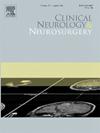经蝶窦手术后张力性气套:系统回顾
IF 1.8
4区 医学
Q3 CLINICAL NEUROLOGY
引用次数: 0
摘要
目的内窥镜鼻内镜经蝶手术(EETS)是切除垂体腺瘤等蝶窦病变的常用一线方法。虽然这些手术在很大程度上是成功的,但也会出现罕见或意想不到的并发症。其中一种并发症就是张力性肺气肿(TP)。方法根据《系统综述和元分析首选报告项目》指南,使用 PubMed、Google Scholar、Embase、Cochrane 和 Web of Science 电子数据库进行系统综述,对讨论 EETS 术后 TP 的主要文章进行严格评估。结果收录了1995年至2023年间发表的11篇文章,其中详细描述了12例TP病例,主要是经蝶窦手术治疗垂体瘤(9例)或Rathke裂囊肿(2例)后出现的TP。常见症状包括头痛(7 例)和视觉障碍(2 例)。TP的发病时间从术后两天到术后十三年不等,CSF漏、蝶窦缺损和包装不足是风险因素。内镜减压和手术修补是最常见的治疗方法(9 例),其余 3 例患者采用抗生素保守治疗;所有病例均取得了良好的疗效。对于有症状的 TP 患者,可以通过内窥镜减压和修复蝶窦底,并对蝶窦进行脂肪填充。对于无症状的患者,术后扫描中偶然发现的 TP 可采取保守治疗。本文章由计算机程序翻译,如有差异,请以英文原文为准。
Tension pneumosella following transsphenoidal surgery: A systematic review
Objective
Endoscopic endonasal transsphenoidal surgery (EETS) is a common first-line approach for resection of sellar lesions such as pituitary adenomas. While these procedures are largely successful, rare or unexpected complications can occur. One such complication is tension pneumosella (TP). Here, we conducted a systematic review of the literature to provide recommendations on how best to identify, manage and prevent TP post-EETS.
Methods
A systematic review was conducted using PubMed, Google Scholar, Embase, Cochrane and Web of Science electronic databases according to the Preferred Reporting Items for Systematic Reviews and Meta-Analyses guidelines to critically assess primary articles discussing TP following EETS.
Results
Eleven articles published between 1995 and 2023 detailing twelve (12) cases of TP, primarily following transsphenoidal surgery for pituitary tumors (9 cases) or Rathke cleft cysts (2 cases) were included. Common symptoms included headaches (7 cases) and visual disturbances (2 cases). TP onset ranged from two days to thirteen years after surgery, with CSF leaks, sellar defects, and inadequate packing as risk factors. Endoscopic decompression and surgical repair were the most common treatments (9 cases), while the remaining three patients were managed conservatively with antibiotics; all cases with favorable outcomes.
Conclusions
Our review highlights TP as a rare yet important consideration to be aware of and its variable presentation following EETS. In patients with symptomatic TP, endoscopic decompression and repair of the sellar floor with fat packing of the sphenoid sinus is acceptable. Incidentally discovered TP on postoperative scans in otherwise asymptomatic patients can be conservatively managed.
求助全文
通过发布文献求助,成功后即可免费获取论文全文。
去求助
来源期刊

Clinical Neurology and Neurosurgery
医学-临床神经学
CiteScore
3.70
自引率
5.30%
发文量
358
审稿时长
46 days
期刊介绍:
Clinical Neurology and Neurosurgery is devoted to publishing papers and reports on the clinical aspects of neurology and neurosurgery. It is an international forum for papers of high scientific standard that are of interest to Neurologists and Neurosurgeons world-wide.
 求助内容:
求助内容: 应助结果提醒方式:
应助结果提醒方式:


